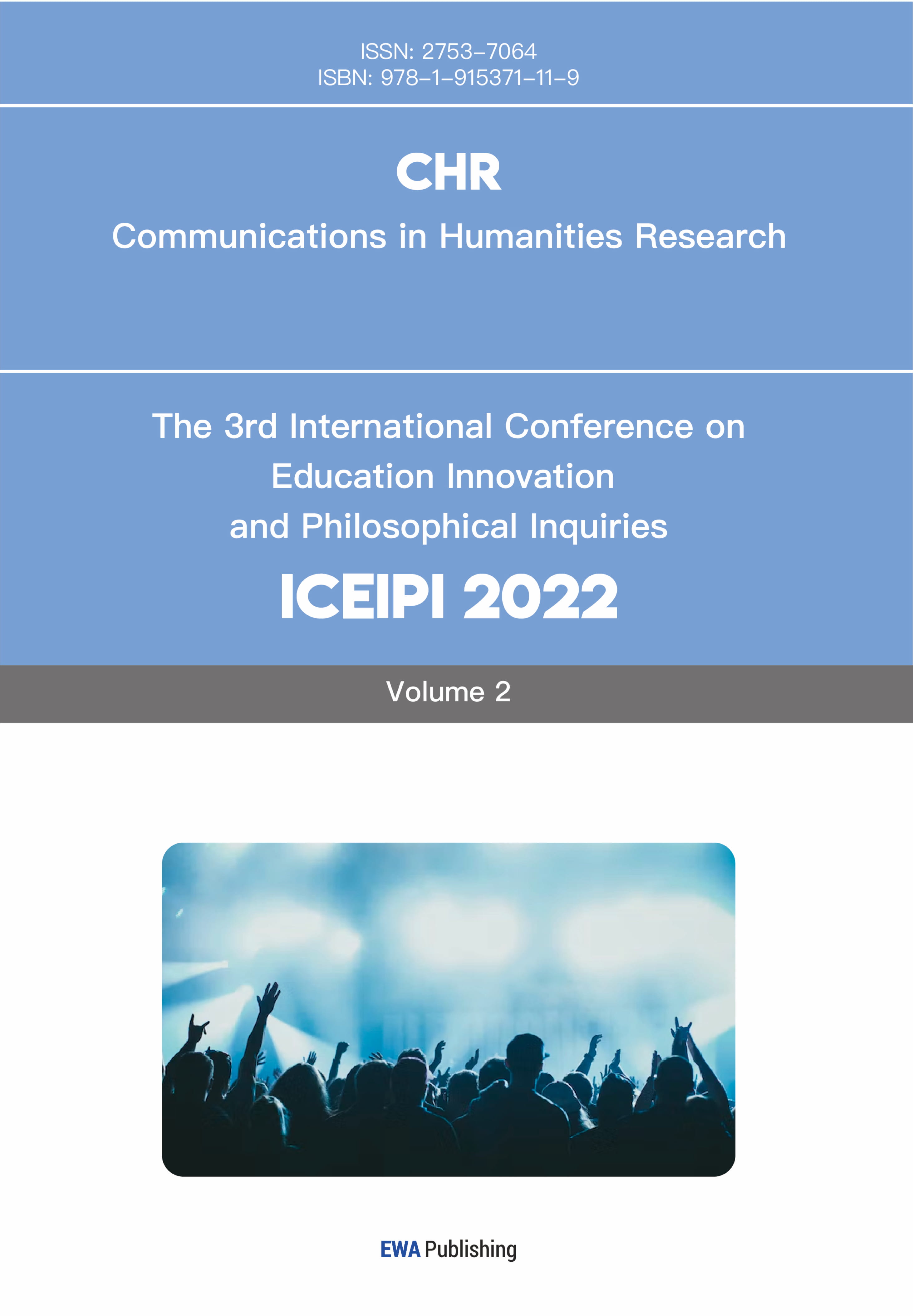References
[1]. Li Qian, Chen Hong. Innovative application of narrative language in immersive digital images [J]. Journal of heihe university, 2020,11(05):140-141+147.
[2]. van Krevelen, D. W. F., & Poelman, R. (2010). A survey of augmented reality technologies, applications and limitations. International Journal of Virtual Reality, 9(2), 1-20.
[3]. Gao Yuna. Narrative Method of "Telling Stories" Exhibition: An Analysis Based on the Theory of "Stories and Discourse" [J]. Science Museum Research, 2019, 4 (06): 13-17+91.
[4]. Sun Kejia, Guan Ling. From narrative theory to interactive practice: the emergence and development of interactive film and television [J]. editorial friend, 2022 (02): 69-75.
[5]. Zhang Zuyao, Ye Liuqin. Research on the design of museum cultural products based on multi-sensory experience [J]. Packaging Engineering, 2021, 42 (18): 368-373.
[6]. Shi Xiaodong. Online and Presence: Research on Interactive Design Strategies of Exhibitions Based on Personal Cognition [J]. Decoration, 2019 (07): 96-99.
[7]. Shi T. Research An the Aesthetic Image of Interaction Design in Immersive Art Exhibition--Take Teamlab Borderless Digital Art Museum as an Example[J]. International Journal of Social Science and Education Research, 2020, 3(12): 429-435.
[8]. Kong Cuiting, Pan Husheng, Zhang Lie. Research on museum somatosensory interaction design from the perspective of embodied cognition [J]. Decoration, 2020 (03): 90-93.
[9]. Campos, A. C., Mendes, J., do Valle, P. O., & Scott, N. (2018). Co-creation of tourist experiences: A literature review. Current Issues in Tourism, 21(4), 369-400.
[10]. Vi C T, Ablart D, Gatti E, et al. Not just seeing, but also feeling art: Mid-air haptic experiences integrated in a multisensory art exhibition[J]. International Journal of Human-Computer Studies, 2017, 108: 1-14.
Cite this article
Chen,Y. (2023). Research on the Narrative Art’s Artistic Expression of Digital Images in Museums — A Case Study of H.C Andersson's House. Communications in Humanities Research,3,55-62.
Data availability
The datasets used and/or analyzed during the current study will be available from the authors upon reasonable request.
Disclaimer/Publisher's Note
The statements, opinions and data contained in all publications are solely those of the individual author(s) and contributor(s) and not of EWA Publishing and/or the editor(s). EWA Publishing and/or the editor(s) disclaim responsibility for any injury to people or property resulting from any ideas, methods, instructions or products referred to in the content.
About volume
Volume title: Proceedings of the International Conference on Interdisciplinary Humanities and Communication Studies (ICIHCS 2022), Part 1
© 2024 by the author(s). Licensee EWA Publishing, Oxford, UK. This article is an open access article distributed under the terms and
conditions of the Creative Commons Attribution (CC BY) license. Authors who
publish this series agree to the following terms:
1. Authors retain copyright and grant the series right of first publication with the work simultaneously licensed under a Creative Commons
Attribution License that allows others to share the work with an acknowledgment of the work's authorship and initial publication in this
series.
2. Authors are able to enter into separate, additional contractual arrangements for the non-exclusive distribution of the series's published
version of the work (e.g., post it to an institutional repository or publish it in a book), with an acknowledgment of its initial
publication in this series.
3. Authors are permitted and encouraged to post their work online (e.g., in institutional repositories or on their website) prior to and
during the submission process, as it can lead to productive exchanges, as well as earlier and greater citation of published work (See
Open access policy for details).
References
[1]. Li Qian, Chen Hong. Innovative application of narrative language in immersive digital images [J]. Journal of heihe university, 2020,11(05):140-141+147.
[2]. van Krevelen, D. W. F., & Poelman, R. (2010). A survey of augmented reality technologies, applications and limitations. International Journal of Virtual Reality, 9(2), 1-20.
[3]. Gao Yuna. Narrative Method of "Telling Stories" Exhibition: An Analysis Based on the Theory of "Stories and Discourse" [J]. Science Museum Research, 2019, 4 (06): 13-17+91.
[4]. Sun Kejia, Guan Ling. From narrative theory to interactive practice: the emergence and development of interactive film and television [J]. editorial friend, 2022 (02): 69-75.
[5]. Zhang Zuyao, Ye Liuqin. Research on the design of museum cultural products based on multi-sensory experience [J]. Packaging Engineering, 2021, 42 (18): 368-373.
[6]. Shi Xiaodong. Online and Presence: Research on Interactive Design Strategies of Exhibitions Based on Personal Cognition [J]. Decoration, 2019 (07): 96-99.
[7]. Shi T. Research An the Aesthetic Image of Interaction Design in Immersive Art Exhibition--Take Teamlab Borderless Digital Art Museum as an Example[J]. International Journal of Social Science and Education Research, 2020, 3(12): 429-435.
[8]. Kong Cuiting, Pan Husheng, Zhang Lie. Research on museum somatosensory interaction design from the perspective of embodied cognition [J]. Decoration, 2020 (03): 90-93.
[9]. Campos, A. C., Mendes, J., do Valle, P. O., & Scott, N. (2018). Co-creation of tourist experiences: A literature review. Current Issues in Tourism, 21(4), 369-400.
[10]. Vi C T, Ablart D, Gatti E, et al. Not just seeing, but also feeling art: Mid-air haptic experiences integrated in a multisensory art exhibition[J]. International Journal of Human-Computer Studies, 2017, 108: 1-14.









